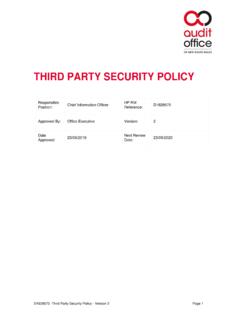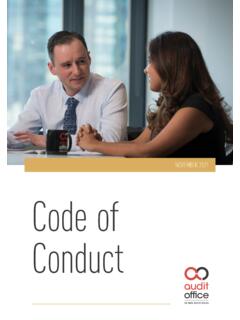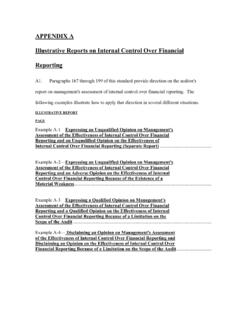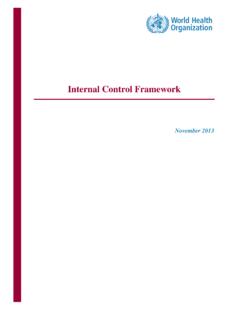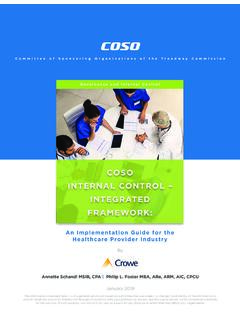Transcription of Internal Control Framework - Audit Office of New South Wales
1 Internal Control Framework October 2019 contents 1 Introduction 1 2 What is an Internal Control Framework 1 3 Why have an effective Internal Control Framework ? 1 4 Three lines of defence 2 5 Responsibilities 3 6 Components of Internal Control 3 7 Limitations of Internal Control 7 8 Annual CFO certification and management Control questionnaire 8 9 Contact Point 8 10 Review 8 Our insights inform and challenge government to improve outcomes for citizens D1904341 Internal Control Framework October 2019 1 1 Introduction In 2013 the Committee of Sponsoring Organizations of the Treadway Commission ( coso ) released its revised Internal Control Integrated Framework . It is recognised as a leading Framework for designing, implementing, and conducting Internal Control and assessing the effectiveness of Internal Control . The Audit Office s Internal Control Framework is based on the Internal Control guidelines recommended by the coso as adopted by the auditing profession as their definition of Internal Control .
2 2 What is an Internal Control Framework coso defines Internal Control as a process, effected by an entity s board of directors, management, and other personnel, designed to provide reasonable assurance regarding the achievement of objectives relating to operations, reporting, and compliance. This definition reflects certain fundamental concepts. Internal Control is: geared to the achievement of objectives a process consisting of ongoing tasks and activities - a means to an end, not an end in itself effected by people - not merely about policy and procedures, systems, and forms, but about people and the actions they take at every level of the Audit Office to affect Internal Control able to provide reasonable assurance - but not absolute assurance, to an entity s senior management and the Office Executive adaptable to the entity structure - flexible in application for the entire Audit Office , branch, unit or business process. An effective Internal Control system provides reasonable, but not absolute, assurance that assets are safeguarded, financial and other information is reliable, laws, directions and Audit Office policies are being complied with and that errors and fraud are prevented.
3 3 Why have an effective Internal Control Framework ? Internal controls are used to help the Audit Office achieve its goals and objectives. By identifying risks that will prevent these goals and objectives being achieved, we can identify what effective controls we need to have in place. Effective Internal controls help to mitigate: Reputational risk so that the Audit Office continues to be recognised for its independence and integrity and the value it delivers through high quality independent assurance services. The Audit Office s reputation may be severely damaged if it issues an incorrect opinion, conclusion or misleading report. Strategic and Operational risks so that the Audit Office s objectives and goals are achieved, resources are acquired economically and employed efficiently, and quality business processes and continuous improvement are emphasised. Fraud risk so that the Audit Office s resources (including its people, systems and information) are adequately protected.
4 Compliance risk so that the actions of all staff comply with Audit Office policies, plans and procedures and all relevant laws, standards, central agency directions and applicable Auditor-General s report recommendations. The risk of error in the Audit Office s financial statements so that internally and externally published information is accurate, reliable and timely. Our insights inform and challenge government to improve outcomes for citizens D1904341 Internal Control Framework October 2019 2 4 Three lines of defence The Three Lines of Defence model provides a simple and effective way to communicate the roles and responsibilities surrounding risk and controls within the Audit Office to achieve our objectives. The three lines of defence are: 1. First line of defence: owns and manages Comprises of senior management and risk owners who implement and maintain operational controls in each branch or unit or specific areas of responsibility. This involves Directors and Executive Managers but may also include risk owners within specific functions such as WHS or Information Security.
5 2. Second line of defence: oversees Comprises specialist functions that are independent of the first line of defence and challenge and provide oversight over business processes and risks. This will include the Chief Risk Officer, Chief Finance Officer, QARC and Project Steering Committees. 3. Third line of defence: provides independent assurance Comprises independent assurance that the first and second lines of defence are operating effectively, and improvements are identified and recommended. This includes the Internal Audit function and peer reviews which provide independent assurance on the appropriateness and effectiveness of the risk management and Control Framework . The Auditor-General through the Office Executive and Chief Risk Officer provides the governance structure, sets the risk appetite and establishes the risk management culture. The Audit and Risk Committee role is to provide independent assistance to the Auditor-General by monitoring, reviewing and providing advice about the Audit Office s governance processes, risk management and Control frameworks.
6 It does this by oversight and review of the results from the three lines of defence, and more specifically through direct reports from Internal and External Audit . AdviseAUDITOR-GENERAL( Office Executive) Audit AND RISK COMMITTEE3rdline of defenseProvides independent assurance2ndline of defenseOversees1stline of defenseOwns and managesExternal AuditPAC (quadrennial review)Provides independent assurance by evaluating and giving an opinion on the adequacy and effectiveness of risk management and and challenges(including testing) the effectiveness of controls by having oversight of business processes and owners & management who implement and maintain operational controls and demonstrate controls are auditACAG peer reviewsDAG, FAE, PAE, QARC, TICCFO, CIO, CRO, CAEWHS Committee, Remuneration Committee, Project Steering CommitteesManagement ControlsInternal Control Measures(policies, procedures, systems, frameworks, structures and people)AssuranceAssurance Our insights inform and challenge government to improve outcomes for citizens D1904341 Internal Control Framework October 2019 3 5 Responsibilities The Auditor-General has ultimate responsibility for ensuring an effective system of Internal Control over the financial and related operations of the Audit Office , in line with the requirements of the Public Finance and Audit Act 1983.
7 The Deputy Auditor-General, as Chief Executive Officer, has responsibility for the Audit Office s Internal Control Framework . The Office Executive is accountable for oversight of Internal Control by establishing policies and expectations of conduct, setting the tone at the top and managing risk in the Audit Office . The Office Executive is responsible for ensuring necessary controls and treatment plans are in place to effectively manage risk. Members of the Office Executive also attend Audit and Risk Committee meetings as requested to discuss the current management of specific risks and Internal controls. The Chief Finance Officer (CFO) is responsible for conducting the annual management Internal Control questionnaire as part of the annual CFO certification as to the effectiveness of the system of Internal Control over financial information. The Executive Manager, Governance, on behalf of the Chief Risk Officer, prepares status reports for the Office Executive and Audit and Risk Committee as required regarding the Audit Office s Internal Control Framework .
8 All Audit Office Managers (Directors, Executive Managers and Executive Directors) are responsible for contributing and achieving the Audit Office Strategic Plan; and establishing, documenting, assessing and maintaining Internal controls that mitigate risk within their team and ensuring staff in their team, have complied with applicable Audit Office policies. Audit Office Managers are the first line of defence. Audit Office managers may have either a primary or secondary responsibility in ensuring compliance with Audit Office policies. Primary responsibilities exist where a policy relates directly to a person s role or area of expertise. While secondary responsibility exists where Audit Office Managers have responsibility for specific aspects of policy implementation by ensuring team members adhere to or conduct activities in accordance with relevant policies. For example, the Audit Office Leave Policy is owned and managed by the Executive Manager HR, who is responsible for Audit Office wide implementation and awareness of the policy, and providing advice and training where needed.
9 While a Director, Executive Manager or Executive Director is responsible for reviewing and approving leave entitlements in accordance with the leave policy. All Audit Office staff including temporary staff and contractors must comply with Internal controls and applicable Audit Office policies within the scope of their roles. They are also responsible for reporting to management instances where they consider Internal Control procedures are not adequate or are not being complied with. The Audit and Risk Committee is responsible provide independent assistance to the Auditor-General by monitoring, reviewing and providing advice about the Audit Office s governance processes, risk management and Control frameworks. 6 Components of Internal Control The Audit Office has five primary components of Internal controls based on the coso guidelines (see section 1 above for an explanation of coso ): Control Environment Risk Assessment Control Activities Information and Communication Monitoring.
10 Our insights inform and challenge government to improve outcomes for citizens D1904341 Internal Control Framework October 2019 4 Control Environment A Control environment, where competent people understand their responsibilities and authority and are committed to acting appropriately, will provide a foundation for Internal controls to exist and operate effectively. The Office Executive establishes the tone at the top regarding the importance of Internal Control including expected standards of conduct. Management reinforces expectations at the various levels of the organisation. To ensure all Audit Office staff are aware of their responsibilities, training and updates are provided on a timely basis and applicable Audit Office policies and procedures are published on the Audit Office intranet. An effective Internal Control environment for the Audit Office includes: the Office Executive provides governance oversight by having appropriate management philosophy and operating style, providing the right tone at the top regarding the importance of Internal controls and ensuring the development and performance of Internal controls maintaining integrity and ethical values (refer to the Code of Conduct and related policies such as the Conflict of Interest Policy and other Employee Conduct and Obligations policies) processes to attract, develop and retain competent people through appropriate selection processes, regular performance reviews, learning development programs and adequate training establishing structures, reporting lines and appropriate authorities and responsibilities to meet objectives (including the Delegations Manual) complying with relevant laws, central agency directions (see Compliance Policy and Register)

